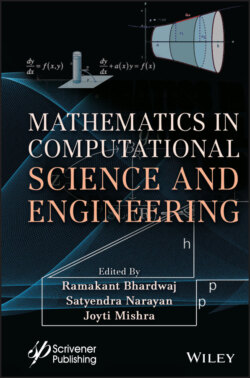Читать книгу Mathematics in Computational Science and Engineering - Группа авторов - Страница 2
Table of Contents
Оглавление1 Cover
5 Preface
6 1 Brownian Motion in EOQ 1.1 Introduction 1.2 Assumptions in EOQ 1.3 Methodology 1.4 Results 1.5 Discussion 1.6 Conclusions References
7 2 Ill-Posed Resistivity Inverse Problems and its Application to Geoengineering Solutions 2.1 Introduction 2.2 Fundamentals of Ill-Posed Inverse Problems 2.3 Brief Historical Development of Resistivity Inversion 2.4 Overview of Inversion Schemes 2.5 Theoretical Basis for Multi-Dimensional Resistivity Inversion Technqiues 2.6 Mathematical Concept for Application to Geoengineering Problems 2.7 Mathematical Quantification of Resistivity Resolution and Detection 2.8 Scheme of Resistivity Data Presentation 2.9 Design Strategy for Monitoring Processes of IOR Projects, Geo-Engineering, and Geo-Environmental Problems 2.10 Final Remarks and Conclusions References
8 3 Shadowed Set and Decision-Theoretic Three-Way Approximation of Fuzzy Sets 3.1 Introduction 3.2 Preliminaries on Three-Way Approximation of Fuzzy Sets 3.3 Theoretical Foundations of Shadowed Sets 3.4 Principles for Constructing Decision-Theoretic Approximation 3.5 Concluding Remarks and Future Directions References
9 4 Intuitionistic Fuzzy Rough Sets: Theory to Practice 4.1 Introduction 4.2 Preliminaries 4.3 Intuitionistic Fuzzy Rough Sets 4.4 Extension and Hybridization of Intuitionistic Fuzzy Rough Sets 4.5 Applications of Intuitionistic Fuzzy Rough Sets 4.6 Work Distribution of IFRS Country-Wise and Year-Wise 4.7 Conclusion Acknowledgement References
10 5 Satellite-Based Estimation of Ambient Particulate Matters (PM2.5) Over a Metropolitan City in Eastern India 5.1 Introduction 5.2 Methodology 5.3 Result and Discussions 5.4 Conclusion References
11 6 Computational Simulation Techniques in Inventory Management 6.1 Introduction 6.2 Conclusion References
12 7 Workability of Cement Mortar Using Nano Materials and PVA 7.1 Introduction 7.2 Literature Survey 7.3 Materials and Methods 7.4 Results and Discussion 7.5 Conclusion References
13 8 Distinctive Features of Semiconducting and Brittle Half-Heusler Alloys; LiXP (X=Zn, Cd) 8.1 Introduction 8.2 Computation Method 8.3 Result and Discussion 8.4 Conclusions Acknowledgement References
14 9 Fixed Point Results with Fuzzy Sets 9.1 Introduction 9.2 Definitions and Preliminaries 9.3 Main Results References
15 10 Role of Mathematics in Novel Artificial Intelligence Realm 10.1 Introduction 10.2 Mathematical Concepts Applied in Artificial Intelligence 10.3 Work Flow of Artificial Intelligence & Application Areas 10.4 Conclusion References
16 11 Study of Corona Epidemic: Predictive Mathematical Model 11.1 Mathematical Modelling 11.2 Need of Mathematical Modelling 11.3 Methods of Construction of Mathematical Models 11.4 Comparative Study of Mathematical Model in the Time of Covid-19 – A Review 11.5 Corona Epidemic in the Context of West Bengal: Predictive Mathematical Model References
17 12 Application of Mathematical Modeling in Various Fields in Light of Fuzzy Logic 12.1 Introduction 12.2 Fuzzy Logic 12.3 Literature Review 12.4 Applications of Fuzzy Logic 12.5 Conclusion References
18 13 A Mathematical Approach Using Set & Sequence Similarity Measure for Item Recommendation Using Sequential Web Data 13.1 Introduction 13.2 Measures of Assessment for Recommendation Engines 13.3 Related Work 13.4 Methodology/Research Design 13.5 Finding or Result 13.6 Conclusion and Future Work References
19 14 Neural Network and Genetic Programming Based Explicit Formulations for Shear Capacity Estimation of Adhesive Anchors 14.1 General Introduction 14.2 Research Significance 14.3 Biological Nervous System 14.4 Constructing Artificial Neural Network Model 14.5 Genetic Programming (GP) 14.6 Administering Genetic Programming Scheme 14.7 Genetic Programming In Details 14.8 Genetic Expression Programming 14.9 Developing Model With Genexpo Software 14.10 Comparing NN and GEP Results 14.11 Conclusions References
20 15 Adaptive Heuristic - Genetic Algorithms 15.1 Introduction 15.2 Genetic Algorithm 15.3 The Genetic Algorithm 15.4 Evaluation Module 15.5 Populace Module 15.6 Reproduction Module 15.7 Example 15.8 Schema Theorem 15.9 Conclusion 15.10 Future Scope References
21 16 Mathematically Enhanced Corrosion Detection 16.1 Introduction 16.2 Case Study: PCA Applied to PMI Data for Defect Detection 16.3 PCA Feature Extraction for PMI Method 16.4 Experimental Setup and Test 16.5 Results 16.6 Conclusions References
22 17 Dynamics of Malaria Parasite with Effective Control Analysis 17.1 Introduction 17.2 The Mathematical Structure of EGPLC 17.3 The Modified EGPLC Model 17.4 Equilibria and Local Stability Analysis 17.5 Analysis of Global Stability 17.6 Global Stability Analysis with Back Propagation 17.7 Stability Analysis of Non-Deterministic EGPLC Model 17.8 Discussion on Numerical Simulation 17.9 Conclusion 17.10 Future Scope of the Work References
23 18 Dynamics, Control, Stability, Diffusion and Synchronization of Modified Chaotic Colpitts Oscillator with Triangular Wave Non-Linearity Depending on the States 18.1 Introduction 18.2 The Mathematical Model of Chaotic Colpitts Oscillator 18.3 Adaptive Backstepping Control of the Modified Colpitts Oscillator with Unknown Parameters 18.4 Synchronization of Modified Chaotic Colpitts Oscillator 18.5 The Synchronization of Colpitts Oscillator via Backstepping Control 18.6 Circuit Implementation 18.7 Conclusion References
24 Index
